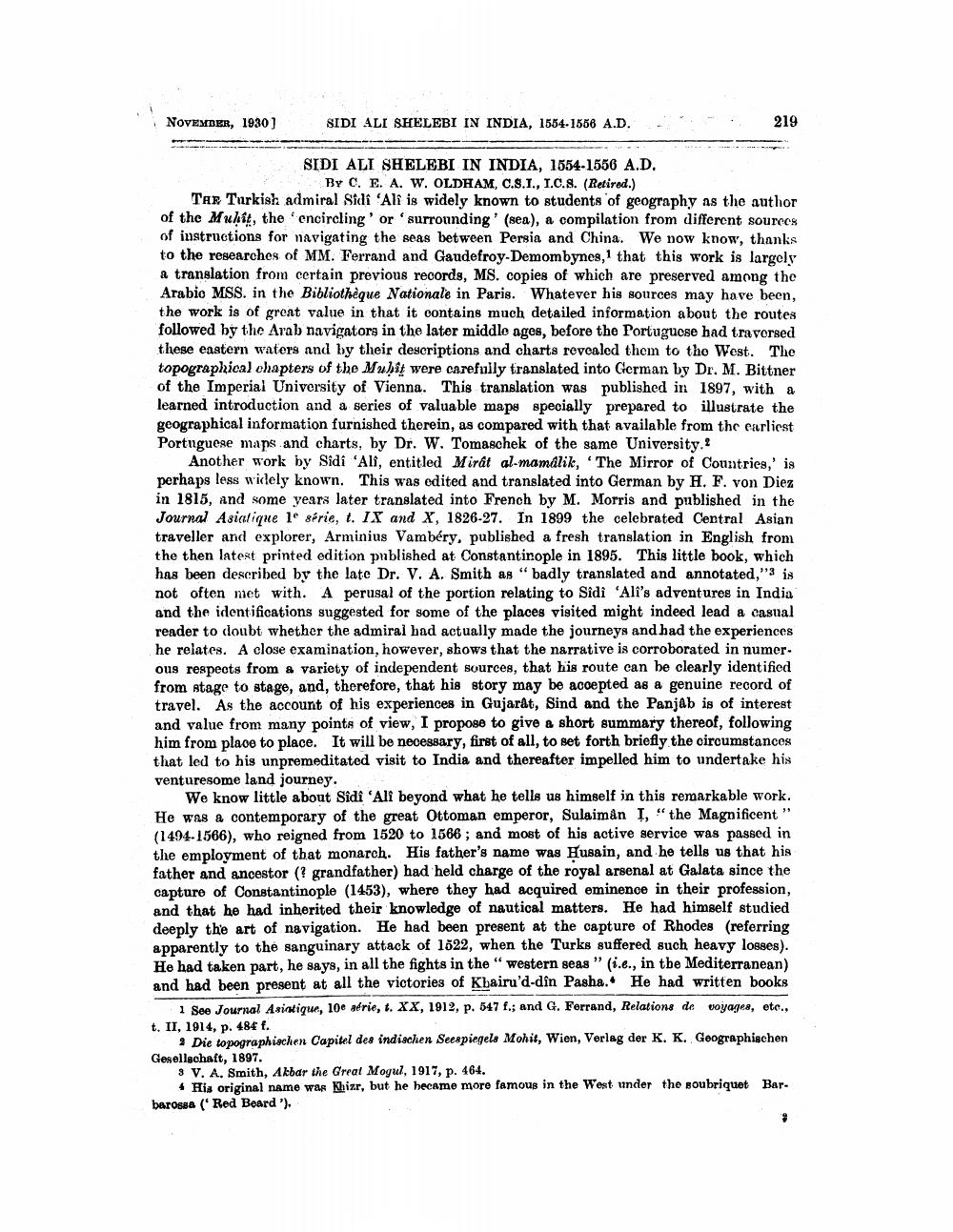________________
NOVEMBER, 1930)
SIDI ALI SHELEBI IN INDIA, 1564-1666 A.D.
.
-
219
----
SIDI ALI SHELEBI IN INDIA, 1554-1556 A.D.
By C. E. A. W. OLDHAM, C.8.1., I.C.S. (Retired.) TAR Turkish admiral Sidi 'Ali is widely known to students of geography as the author of the Muhit, the encircling' or surrounding' (sea), a compilation from different sources of instructions for navigating the seas between Pergia and China. We now know, thanks to the researches of MM. Ferrand and Gaudefroy-Demombynes, 1 that this work is largely a translation from certain previous records, MS. copies of which are preserved among the Arabic MSS. in the Bibliothèque Nationale in Paris. Whatever his sources may have been, the work is of great value in that it contains much detailed information about the routes followed by the Arab navigators in the later middle ages, before the Portuguese had travorsed these eastern waters and by their descriptions and charts revealed them to the West. The topographical chapters of the Muhit were carefully translated into German by Dr. M. Bittner of the Imperial University of Vienna. This translation was published in 1897, with a learned introduction and a series of valuable maps specially prepared to illustrate the geographical information furnished therein, as compared with that available from the earliest Portnguege maps and charts, by Dr. W. Tomaschek of the same University.
Another work by Sidi 'Ali, entitled Mirat al-mamalik, The Mirror of Countries,' is perhaps less widely known. This was odited and translated into German by H. F. von Diez in 1815, and some years later translated into French by M. Morris and published in the Journal Asiatique 1° série, t. IX and X, 1826-27. In 1899 the celebrated Central Asian traveller and explorer, Arminius Vambéry, published a fresh translation in English from the then latest printed edition published at Constantinople in 1895. This little book, which has been described by the late Dr. V. A. Smith as "badly translated and annotated,"3 is not often met with. A perusal of the portion relating to Sidi 'Ali's adventures in India and the identifications suggested for some of the places visited might indeed lead a casual reader to doubt whether the admiral had actually made the journeys and had the experiences he relates. A close examination, however, shows that the narrative is corroborated in numer. ous respects from a variety of independent sources, that his route can be clearly identified from stage to stage, and, therefore, that his story may be acoepted as a genuine record of travel. As the account of his experiences in Gujarat, Sind and the Panjab is of interest and value from many points of view, I propose to give a short summary thereof, following him from place to place. It will be necessary, first of all, to set forth briefly the circumstances that led to his unpremeditated visit to India and thereafter impelled him to undertake his venturesome land journey.
We know little about Sidi 'Ali beyond what he tells us himself in this remarkable work. He was a contemporary of the great Ottoman emperor, Sulaiman I, "the Magnificent " (1494-1566), who reigned from 1520 to 1566; and most of his active service was passed in the employment of that monarch. His father's name was Husain, and he tells us that his father and ancestor (? grandfather) had held charge of the royal arsenal at Galata since the capture of Constantinople (1453), where they had acquired eminence in their profession, and that he had inherited their knowledge of nautical matters. He had himself studied deeply the art of navigation. He had been present at the capture of Rhodes (referring apparently to the sanguinary attack of 1522, when the Turks suffered such heavy losses). He had taken part, he says, in all the fights in the" western seas" (i.e., in the Mediterranean) and had been present at all the victories of Khairu'd-dîn Pasha.He had written books
1 See Journal Asiatique, 10e aérie, t. xx, 1912, p. 547 f.; and G. Ferrand, Relations de voyages, etc., t. II, 1914, p. 484 f.
· Die topographischen Capitel des indischen Seespiegels Mohit, Wien, Verlag der K. K. Geographischen Gesellschaft, 1897.
9 V. A. Smith, Akbar the Great Mogul, 1917, p. 464.
4 Hia original name was Khizr, but he became more famous in the West under the soubriquet Bar. barossa ("Red Beard ').




